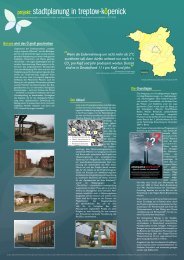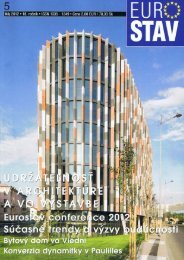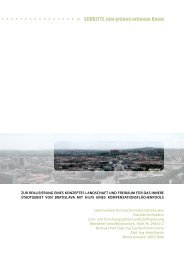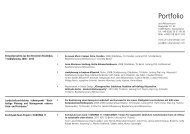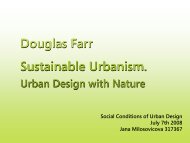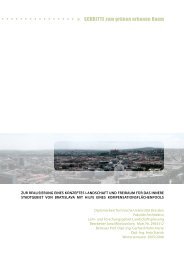Thesis document - Jana Milosovicova - Urban Design English
Thesis document - Jana Milosovicova - Urban Design English
Thesis document - Jana Milosovicova - Urban Design English
- No tags were found...
You also want an ePaper? Increase the reach of your titles
YUMPU automatically turns print PDFs into web optimized ePapers that Google loves.
a.b.-°C-°C50-300 m-°CNot only temperature decrease, but also the increase in air humidity 29can be measured in the proximity of water bodies in urban areas. Itwas observed that changes of the relative humidity in densely built-upareas are evident up to 50 m. In areas that are less densely developed,this influence may be up to 150 m. When building complexes are looselyarranged, and their long axes are perpendicular to the water’s edge,a particularly favorable distribution of the air humidity is possible. Inthis case, the influence of up to 300 m wide range in the cultivatedarea, producing humidity raise of up to 5% (Sukopp and Wittig 1998,p. 162) (fig. 41a,b).Fig. 41 Perpendicular orientation of the buildings’long axes to the water body enables freshair and humidity permeate into the settlement.The cooling effect of the water body and raisingthe humidity range up to 300 m (in dense areasthe positive climatic influence of the water bodyis about 50 m) (a).To raise the density and take the highest advantageof the water location, buildings’ abovethe ground might be built in a permeable way(b).Thus, the larger and the shallower the riparian, natural-like wateredge areas, the better – for both evaporation (which has theeffects of cooling and rising the air humidity) and ventilation. Additionally,enlarging of the water surface area and its interweavingwith the built-up areas is the best design way, since the climaticeffect is claimed to be highest where the built-up area meets the waterbody’s edge (Song 2003, p. 68).Vegetation in urban design – Parks and greenareasThe climatic effects of urban green in cities are in improving the airquality and urban climate through the retention, absorption and evapotranspirationof rainwater; returning the rainwater in form of vapourto the small water cycle; reducing air pollution; reducing the noiseimpact by traffic, neighbours, etc.; positively affecting natural urbanventilation; and providing urban areas with shade and lower temperaturesin hot seasons.However, obviously, in estimating the extent of the positive effects onclimate, there is a need for clarification of two questions (Sukopp andWittig 1998, p. 158):• What size and character must a green space have in order to improvethe climatic situation in the adjacent built-up environment?• Up to what distance from the green space can a positive influenceon the climate in the built-up area be demonstrated?Brief answers to these questions deliver the results of a study concernedwith five green spaces and ruderal areas of different sizes inBerlin. The study determined the range 30 of the climatic effects of thesegreen areas. The greatest effects could be observed on the lee sideof the green spaces. It has been proved that the amplitude of greenspace also plays a significant role – the larger, the greater is the climatologicalrange. The “Großer Garden” features an effect of temperaturereductions up to 1,500 m on the leeward side. However, even againstthe wind direction, on the windward side, the green space can haveclimatic effects up to a depth of 200 m in direction of the built-uparea. (Sukopp and Wittig 1998, p. 159) Here, urban green ventilation29 As brought up in the section 2.2, higher air humidity implies lower UHI effect.30 ‘Range’ meaning the distance from the edge of the green space into the builtuparea, where the minimum temperature difference is 0.5°C, compared to theadjacent urban environment.32Climate Sensitive <strong>Urban</strong> <strong>Design</strong> in Moderate Climate Zone: Responding to Future Heat Waves. Case Study Berlin Heidestrasse/Europacity



